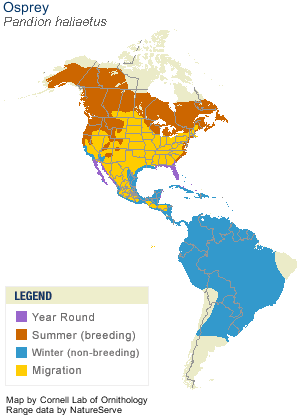 | |
| A regular visitor |
Owls, Manatees, all sorts of visitors to the Keys, however, there is one guest who keeps coming back for regular visits. My friend is an Osprey who happens to enjoy the vantage point of a tall Norfolk Pine located on the property. He especially likes to perch at the very top and call to his partner, who is nesting nearby, ocassionally he brings his lunch and enjoys the view and a meal.
The Osprey |

Hawks
Typical Voice
Size & Shape
Ospreys are very large, distinctively shaped hawks. Despite their size, their bodies are slender, with long, narrow wings and long legs. Ospreys fly with a marked kink in their wings, making an M-shape when seen from below.Color Pattern
Ospreys are brown above and white below, and overall they are whiter than most raptors. From below, the wings are mostly white with a prominent dark patch at the wrists. The head is white with a broad brown stripe through the eye. Juveniles have white spots on the back and buffy shading on the breast.Behavior
Ospreys search for fish by flying on steady wingbeats and bowed wings or circling high in the sky over relatively shallow water. They often hover briefly before diving, feet first, to grab a fish. You can often clearly see an Osprey's catch in its talons as the bird carries it back to a nest or perch.Habitat
Look for Ospreys around nearly any body of water: saltmarshes, rivers, ponds, reservoirs, estuaries, and even coral reefs. Their conspicuous stick nests are placed in the open on poles, channel markers, and dead trees, often over water.
Range Map Help

I saw an Osprey and 2 babies old enough to fly in Sunset Park in Key Colony where I do not live but was taking a walk. They had a bare manmade nest that looked really uncomfortable with no nesting material. I will try and make some calls tomorrow to see if anybody cares and will help
ReplyDelete